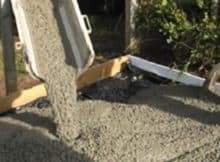What Is Roller Compacted Concrete?
Roller compacted concrete is a type of concrete which contains the same ingredients as traditional concrete. The proportions of ingredients may not be the same as the conventional concrete. In addition to the common ingredients, fly ash is added as a partial replacement for Portland cement.
When roller compacted concrete is in its unhardened state, the consistency of its slump is somewhat stiffer than conventional concrete. So that it can withstand the vibration given to it for its complete compaction.

It is placed in layers of approximate thicknesses of 20cm to 30cm each. Placing the concrete in layers allows the full compaction of the concrete.
When the concrete is fully compacted, properties like destiny, strength, texture, etc., are achieved satisfactorily. Roller compacted concrete is economically cheaper, as it can be used without formwork. Also, it does not require finishing.
The main requirements while using concrete are durability, economy, and strength. Roller compacted concrete fulfills all three requirements stated above.
Ingredients
Roller compacted concrete contains the same raw materials or, say, ingredients that are present in conventional concrete. But their proportion is different from conventional concrete.
In addition to cement, fine aggregates, coarse aggregates, and water fly ash are also added as a partial replacement to Portland cement.
Sometimes, different types of chemical admixtures like water reducers, retarders, accelerators, and superplasticizers are also added to the mixture to form concrete with required and special properties.
The amount of chemical admixtures in roller compacted concrete is higher as compared with the traditional concrete.
Properties Of Roller Compacted Concrete
Compressive Strength
The compressive strength of roller-compacted concrete ranges from 4000psi to 6000psi which is similar to that of conventional concrete.
But some structures have also yielded compressive strength exceeding 7000psi also. This is due to the low water-cement ratio. The low water-cement ratio helps concrete in achieving high compressive strength.
Flexural Strength
The flexural strength of roller compacted concrete can be achieved between 500psi to 1000psi. Flexural strength has a direct relation with the density and compressive strength in this concrete.
Bond Strength
Roller compacted concrete is poured into layers. A layer of approximate thickness of 20cm to 10cm is placed and then it is compacted. Again the same procedure is followed for the next layers.
These layers must have a strong bonding with each other. A sufficient bond strength is achieved only when the concrete layers are thoroughly bonded with each other.
Shrinkage
Due to lower water content, this concrete usually has lower shrinkage and crack formation as compared to conventional concrete.
Characteristics
- Toughness
- Durability
- Strength
- Sustainability
- Versatility, and
- Resistance to freezing and thawing
Applications
Roller compacted concrete is used for
• Concrete pavements for roads, streets, and highways.
• Construction and rehabilitation of concrete dams, ports, airports, storage facilities, parking lots
• Construction and maintenance of light and heavy industrial facilities.
Advantages
Various advantages of this concrete are as follows:
• It is strong and durable due to less water content in its mixture.
• Reinforcement bars are not required in the construction of a concrete element using this type of concrete.
• It does not deform when heavy loads are applied to it.
• It proves to be a cheaper option when compared with conventional concrete.
• Resistant to oil spills, fuels, hydraulic fluids, and other such liquids.
• It gives a smooth finished surface.
• The consumption of cement in roller compacted concrete is lower due to the use of fly ash which is a partial replacement for cement.
• It is capable of resisting high temperatures.
Disadvantages
• Although the dams are efficiently designed and constructed using this concrete when compared with other low-cost options of dams, it might turn out to be more expensive in some situations.
• Sometimes leakage may occur in the dams if compaction is not done properly.
Also Read
If you like this article then please share it with your friends & also like our Facebook Page and join our Telegram Channel.





Wow great article!